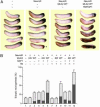Stimulation of NeuroD activity by huntingtin and huntingtin-associated proteins HAP1 and MLK2
- PMID: 12881483
- PMCID: PMC170960
- DOI: 10.1073/pnas.1133382100
Stimulation of NeuroD activity by huntingtin and huntingtin-associated proteins HAP1 and MLK2
Abstract
NeuroD (ND) is a basic helix-loop-helix transcription factor important for neuronal development and survival. By using a yeast two-hybrid screen, we identified two proteins that interact with ND, huntingtin-associated protein 1 (HAP1) and mixed-lineage kinase 2 (MLK2), both of which are known to interact with huntingtin (Htt). Htt is a ubiquitous protein important for neuronal transcription, development, and survival, and loss of its function has been implicated in the pathogenesis of Huntington's disease, a neurodegenerative disorder. However, the mechanism by which Htt exerts its neuron-specific function at the molecular level is unknown. Here we report that Htt interacts with ND via HAP1, and that MLK2 phosphorylates and stimulates the activity of ND. Furthermore, we show that Htt and HAP1 facilitate the activation of ND by MLK2. To our knowledge, ND is the first example of a neuron-specific transcription factor involved in neuronal development and survival whose activity is modulated by Htt. We propose that Htt, together with HAP1, may function as a scaffold for the activation of ND by MLK2.
Figures





Similar articles
-
A human HAP1 homologue. Cloning, expression, and interaction with huntingtin.J Biol Chem. 1998 Jul 24;273(30):19220-7. doi: 10.1074/jbc.273.30.19220. J Biol Chem. 1998. PMID: 9668110
-
HAP1-huntingtin interactions do not contribute to the molecular pathology in Huntington's disease transgenic mice.FEBS Lett. 1998 Apr 17;426(2):229-32. doi: 10.1016/s0014-5793(98)00352-4. FEBS Lett. 1998. PMID: 9599014
-
HAP1 can sequester a subset of TBP in cytoplasmic inclusions via specific interaction with the conserved TBP(CORE).BMC Mol Biol. 2007 Sep 14;8:76. doi: 10.1186/1471-2199-8-76. BMC Mol Biol. 2007. PMID: 17868456 Free PMC article.
-
[The function of Huntington disease gene product (huntingtin) and the pathomechanism of Huntington disease].Nihon Rinsho. 1999 Apr;57(4):905-11. Nihon Rinsho. 1999. PMID: 10222788 Review. Japanese.
-
Regulation of intracellular HAP1 trafficking.J Neurosci Res. 2007 Nov 1;85(14):3025-9. doi: 10.1002/jnr.21326. J Neurosci Res. 2007. PMID: 17474105 Review.
Cited by
-
Elevated SLC7A2 expression is associated with an abnormal neuroinflammatory response and nitrosative stress in Huntington's disease.J Neuroinflammation. 2024 Feb 28;21(1):59. doi: 10.1186/s12974-024-03038-2. J Neuroinflammation. 2024. PMID: 38419038 Free PMC article.
-
Advances in gene and cellular therapeutic approaches for Huntington's disease.Protein Cell. 2025 May 28;16(5):307-337. doi: 10.1093/procel/pwae042. Protein Cell. 2025. PMID: 39121016 Free PMC article. Review.
-
In vivo cell-autonomous transcriptional abnormalities revealed in mice expressing mutant huntingtin in striatal but not cortical neurons.Hum Mol Genet. 2011 Mar 15;20(6):1049-60. doi: 10.1093/hmg/ddq548. Epub 2010 Dec 20. Hum Mol Genet. 2011. PMID: 21177255 Free PMC article.
-
Biological functions and potential therapeutic applications of huntingtin-associated protein 1: progress and prospects.Clin Transl Oncol. 2022 Feb;24(2):203-214. doi: 10.1007/s12094-021-02702-w. Epub 2021 Sep 26. Clin Transl Oncol. 2022. PMID: 34564830 Review.
-
Physical exercise-induced adult neurogenesis: a good strategy to prevent cognitive decline in neurodegenerative diseases?Biomed Res Int. 2014;2014:403120. doi: 10.1155/2014/403120. Epub 2014 Apr 9. Biomed Res Int. 2014. PMID: 24818140 Free PMC article. Review.
References
MeSH terms
Substances
LinkOut - more resources
Full Text Sources
Other Literature Sources
Research Materials
Miscellaneous

